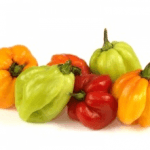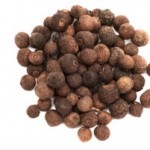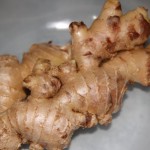Jamaican cuisine draws heavily on the culinary traditions of the people who have called it home – the Tainos, the original people, Africans, Spanish, English, Portuguese, Indian, Chinese, and our own Rastafarians.
However, almost everyone associates our cuisine with pepper, specifically Scotch bonnet. But you’d be wrong to believe that we rely solely on Scotch bonnet to fire up our food. Here are five ingredients that you’re guaranteed to find in every Jamaican pantry.
Scotch Bonnet pepper – One of the hottest peppers in the world, Scotch bonnet got its name because it resembles the tam (bonnet) a Scott wears. The mature pepper can be green, red, orange or yellow. You’ll find Scotch bonnet in just about every dish, from soups to stews. Along with several other spices, it gives jerk its heat.
Pimento – Pimento is the dried fruit of the pimento tree. Jamaica is one of the main producers of pimento. In 1693, it was introduced to the market as a “sweet scented Jamaican pepper” but you might know as “allspice” because it has the combined flavor of cloves, nutmeg, pepper and cinnamon. We not only use the dried fruit, which we use mostly whole, we also use the wood. It is what gives jerk its distinctive, smoky flavor which you won’t get in packaged jerk sauce. We also use pimento to make a delicious liqueur.
Thyme – Another ingredient that revs up the flavor in just about every dish we prepare, from rice and peas to stews, soups and meats. Thyme is typically used fresh, sometimes dried but rarely ever bottled. You’ll find it in local markets bundled with a bunch of scallions, or you can buy it on its own. Let it dry naturally, away from sunlight, and store it in a glass container.
Curry – Curry here refers to the mixture of spices that is used to make curried goat, chicken, etc. Indian indentured servants, who came to island to work on plantations following the abolition of slavery, added curry, as well as roti, to our cuisine. However, the type of curry that is popular in Jamaica is a powdered blend that pales in comparison to the rich, textured curries that India is known for. The Jamaican curry powder has pimento, turmeric, cumin, coriander, fenugreek and anise.
Jerk sauce/seasoning/rub – Like curry, jerk refers to the sauce/seasoning as well as a way of cooking. To jerk is to slow-cooking meat, traditionally pork, over a fire made of pimento wood. The fire releases the oil from the wood, which give the meat its distinctive flavor. In addition to the pimento flavor, the meat is also seasoned with a mixture of spices. That mixture, was until a few years ago, a closely guarded secret. After almost disappearing from local cuisine, jerk made an explosive return around the 1970s with an expanded menu which included chicken, fish and sausage. For many years, Boston Bay in Portland, was the place to go for authentic jerk. Now, jerk stands are as common as patty shops. The main ingredients in jerk sauce/seasoning/rub are thyme, nutmeg, cinnamon, brown sugar, and Scotch bonnet peppers.
- 1 onion, finely chopped
- ½ cup finely chopped scallions, including green parts
- 2 teaspoons fresh thyme leaves
- 2 teaspoons salt
- 1 teaspoon ground pimento (Jamaican allspice)
- ¼ teaspoon ground nutmeg
- ½ teaspoon ground cinnamon
- 4-6 Scotch Bonnet or habanero peppers, seeded and deveined, minced fine
- 1 teaspoon freshly ground black pepper
- Using a mortar and pestle or a food processor, combine all the ingredients and grind to a paste. Store leftover paste in the refrigerator in a tightly closed jar for about 1 month.
Other ingredients you’ll find:
Nutmeg – The dry seed is used primarily in baking, while its outer shell is dried and ground to produce mace, another spice. Nutmeg is indispensable in Jamaican baking.

Coconut /Coconut Milk – In our house, we never made rice and peas without coconut milk, and it wasn’t the processed kind either. Whether you use the milk that has been extracted from shredded coconut or the packaged version, coconut milk is a must have in Jamaican cuisine.
Vinegar – Typically made from cane sugar, vinegar is a key ingredient in escoveitch fish. Vinegar, like lime, is also used to wash meats and fish prior to cooking. It is also used to pickle Scotch bonnet peppers.
Ginger – Introduced into Jamaica around 1525. By 1547, Jamaica was exporting ginger and was one of the three largest producers of ginger in the world between the 1930s and 1960s. The variety of ginger we have in Jamaica is thinner and several times more potent than that in the U.S. We use it in cooking and baking, and also to make homemade ginger beer and sorrel – two drinks that are popular around Christmas.

Browning – Most Jamaicans use browning, which is really burnt sugar, in their Christmas or fruit cakes to give it that rich brown color. Some people also use it in oxtail. Use sparingly. Too much and foods will come out with a bitter taste.
Limes – used to wash fish and meats prior to cooking, to make lemonade, rum punch and sorrel.
How to Join the FoodieTuesday Linkup
Join the FoodieTuesday linkup by –
- Posting a foodie photo on your blog
- Adding the link to your foodie post in the link tool at the bottom of this post
- Visiting participants’ blogs and leaving a comment and/or tweeting their post
- Tweeting this post using the hashtag #FoodieTuesday
Hope to see you at FoodieTuesday!
[inlinkz_linkup id=342233 mode=1 pageSize=300]












A most informative post, Marcia. I’ve always wondered about what made up ‘jerk’ spice! Never could be too spicy for me! (My blog isn’t allowing me to copy and paste direct links to post – another Google quirk I guess – so am simply linking to the blog, sorry!)
This is so awesome that you posted the Homemade Jerk Seasoning recipe, Marcia! I’ve heard you talk about it before and now I can actually make some myself and try it! Hmmm….what should I try it on first is the question? Good post and thank you 🙂
I had no idea what some of these spices looked like before they entered the little jars in my spice cabinet! Fascinating and very educational post my friend!!
I expected the pepper and jerk seasoning – but I wouldn’t have guessed the nutmeg and coconut milk. It sounds delicious!
Looks easy enough to make at home!
Interesting article, thank you, Marcia 🙂
Thanks for this. I always prefer to make my own spice mix most of the time.
Thanks for this. I love making my own spice mix, most of the time anyway. This looks so great!
I’m not a spicy food girl – my taste buds and brain can’t handle the heat. My husband, on the other hand, loves to crank up the heat so I’m sure he’d enjoy Jamaican!
You’re welcome, Lili!
You’re welcome, Mike. I forgot to mention that you can use it as a rub when you barbecue.
Brush it on veggies, sausage, fish even.
It’s making my mouth water just thinking about it!
Very interesting, Marcia. So many yummy ingredients 🙂
This version of the famous jerk method from Boston Bay in Jamaica is a classic example of why spice pastes work so well in grilling: They’re easier to make and impart flavors more directly than a liquid marinade. Sweet-and-sour chutney and an incendiary but hyper-flavorful Scotch bonnet pepper sauce complement the chicken. You probably won’t use all the sauce, but extra keeps, covered and refrigerated, indefinitely. Important note: This dish is EXTREMELY SPICY. While adored by spicy-food lovers for their distinctive flavor, the Scotch bonnet peppers that feature prominently here are some of the hottest chiles you can find. If you prefer a lower heat level, you can dial it down a bit by removing the seeds (which contain much of the heat) from the Scotch bonnets or substituting another type of fresh red or green chile that packs less of a punch.
Fresh, ripe scotch bonnets change from green to colours ranging from yellow to scarlet red. Ripe peppers are prepared for cooking by those who cannot handle the sharp heat by cutting out the area around the seeds inside the fruit, which holds most of the heat. The seeds can be saved for cultivation or other culinary uses.
Thanks for your comment. Best to handle Scotch bonnet with gloves as it can cause your fingers to burn or use a fork to hold it while deseeding it.
One of these days, I’ll plant some of the seeds.
Thanks, Alfredo, very well put.
I see you’re a Boston Bay jerk fan.
Thanks, Sophie!
I love the scotch bonnet peppers and use them frequently.
The sharp heat and unique flavor adds magic to a dish. 🙂
Eliz
My husband is allergic to ginger which drives me nuts as I love the stuff. I also like it hot so I think I would be a huge fan of Jamaican cooking. I didn’t appreciate that thyme was a really common ingredient.
Wow! I wished we have that kind of spice here in my place now, So I could try it, Thanks for sharing this post. Great Job!
Wow, I wonder what’s in ginger that he’s allergic to? You know, more and more I’m hearing of people who have unusual allergies.
Okay, so I know what to get you when we meet. We use a lot of thyme in our cooking.